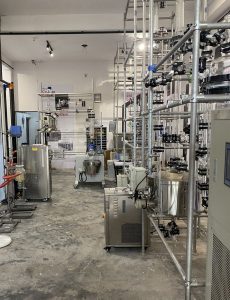Instruções de funcionamento do refrigerador, um sistema de ciclo de controlo da temperatura de processos laboratoriais
The heat transfer medium of the laboratory process temperature control circulation system chiller uses oil and water. It uses electric heating to heat the heat transfer medium (heat transfer oil or water) that is forced to circulate in the pipeline under the action of the pump, and transfers heat energy through heat exchange. And can automatically adjust the temperature to achieve the purpose of accurate temperature control.

1. The installation is simple, the operation is simple, and no professional operation is required. It can be operated by simply training the operator, or by reading the manual; the heating method is circulating heating, so the medium has no loss.
2. The heating is uniform, and the temperature adjustment adopts PID self-tuning intelligent control, which can meet the strict requirements of high process standards. Closed cycle heating, small heat loss, wide range of use.
3. In the pharmaceutical, chemical and other industries, it has the characteristics of fast speed, high temperature resistance, hygienic environment, no automatic heating, and easy to use.
4. Check and set before starting the machine, check whether the installation oil, electricity, gas and pipeline are normal, open the external control panel, enter the visual interface of the operating system, and set the required temperature, but it should be noted that the setting The required temperature is lower than the outlet temperature.
5. Operation detection, start the pump and check the steering of the internal pump and whether the steering of the fan is correct, and then proceed to the next step after confirming that the pump and the fan are running normally.
6. Add the heat transfer oil into the stored expansion oil tank, and through the heat transfer oil circulation, let the heat transfer oil flow through each part of the oil carrier body for the next mechanical operation.
7. Observe whether there is leakage of gas, whether there is leakage in the pipeline, whether the pressure is normal, and whether the temperature is accurate in different environments.
The laboratory process temperature control circulation system chiller is semi-closed, no oil mist volatilizes at high temperature, heat transfer oil will not be oxidized and browned, and will not absorb water vapor in the air at low temperature, which prolongs the service life of the equipment. And it has self-diagnosis function, circulating pump overload protection, high pressure pressure switch, overload relay, thermal protection device and other security functions to fully guarantee the use.
The use method is different from the operation of other simple temperature control equipment, which requires professional technicians to operate, which is not only beneficial to the machine itself of the temperature control equipment, but also greatly helpful to the progress and degree of production work.
Recomendações relacionadas
-
LNEYA está expondo na Achema 2018
838O Grupo LNEYA participará no ACHEMA - Fórum Mundial e Feira Líder para as Indústrias de Processo, Frankfurt am Main, Alemanha, que nos encontrará de 11 a 15 de junho de 2018, bem-vindo ao nosso estande (as informações detalhadas estão chegando),
Ver pormenores -
Método de controlo da paragem do refrigerador arrefecido a água de uma única caldeira de reação
1276The reaction kettle water cooled chiller has a wide range of accessories and equipment. In actual use, it needs to be provided with regular rest time. In order to maintain the stable performance of the refrigerator during long-term operation, it i...
Ver pormenores -
A análise do preço do Ultra Low Freezer
1180What are the characteristics and functions of ultra low freezer:1. Ultra low freezer can prevent the precision of machine equipment from being influenced by the change of oil temperature in the process of operation. 2. Ultra low freezer can preven...
Ver pormenores -
Controlo da temperatura do sistema de controlo dinâmico da temperatura na engenharia de processos
896Na indústria química, especialmente na engenharia de processos, muitos processos estão vinculados a uma temperatura ou podem ser apoiados por aplicações específicas de controlo da temperatura, aumentando assim a eficiência. Um exemplo deste último caso é o controlo contínuo da temperatura...
Ver pormenores
 LNEYA Refrigeradores industriais Fabricante Fornecedor
LNEYA Refrigeradores industriais Fabricante Fornecedor












